The DirectX 12 Performance Preview: AMD, NVIDIA, & Star Swarm
by Ryan Smith on February 6, 2015 2:00 PM EST- Posted in
- GPUs
- AMD
- Microsoft
- NVIDIA
- DirectX 12
DirectX 12 vs. Mantle, Power Consumption
Although the bulk of our coverage today is going to be focused on DirectX 12 versus DirectX 11, we also wanted to take a moment to also stop and look at DirectX 12 and how it compares to AMD’s Mantle. Mantle offers an interesting point of contrast being that it has been in beta longer than DirectX 12, but also due to the fact that it’s an even lower level API than DirectX 12. Since Mantle only needs to work on AMD’s GPUs and can be tweaked for AMD’s architectures, it offers AMD the chance to exploit their GPUs in a few additional ways that a common, cross-vendor API like DirectX 12 cannot.
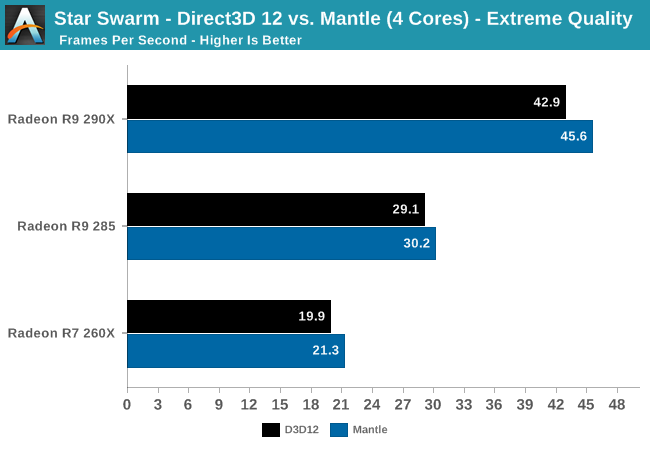
With 4 cores we find that AMD achieves better results with Mantle than DirectX 12 across the board. The gains are never very great – a few percent here and there – but they are consistent and just outside our window of variability for the Star Swarm benchmark. With such a small gain there are a number of factors that can possibly explain this outcome – better developed drivers, better developed application, further benefits of working with a known hardware platform – so we can’t credit any one factor. But it’s safe to say that at least in this one instance, at this time, Star Swarm’s Mantle rendering path produces even better results than its DirectX 12 path on AMD cards.
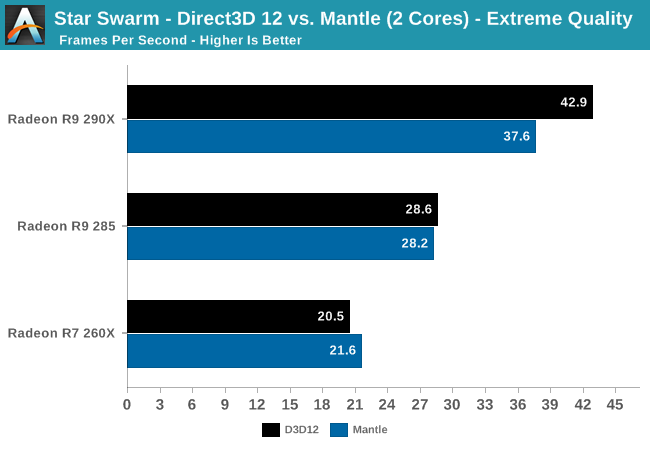
On the other hand, Mantle doesn’t seem to be able to accommodate a two-core situation as well, with the 290X seeing a small but distinct performance regression from switching to Mantle from DirectX 12. Though we didn’t have time to look at an AMD APU for this article, it would be interesting to see if this regression occurs on their 2M/4C parts as well as it does here; AMD is banking heavily on low-level APIs like Mantle to help level the CPU playing field with Intel, so if Mantle needs 4 CPU cores to fully spread its wings with faster cards, that might be a problem.

Diving deeper, we can see that part of the explanation for our Mantle performance regression may come from the batch submission process. DirectX 12 is unexpectedly well ahead of Mantle here, with batch submission taking on average a bit more than half as long as it does under Mantle. As batch submission times are highly correlated to CPU bottlenecking on Star Swarm, this would imply that DirectX 12 would bottleneck later than Mantle in this instance. That said, since we’re so strongly GPU-bound right now it’s not at all clear if either API would be CPU bottlenecked any time soon.
Update: Oxide Games has emailed us this evening with a bit more detail about what's going on under the hood, and why Mantle batch submission times are higher. When working with large numbers of very small batches, Star Swarm is capable of throwing enough work at the GPU such that the GPU's command processor becomes the bottleneck. For this reason the Mantle path includes an optimization routine for small batches (OptimizeSmallBatch=1), which trades GPU power for CPU power, doing a second pass on the batches in the CPU to combine some of them before submitting them to the GPU. This bypasses the command processor bottleneck, but it increases the amount of work the CPU needs to do (though note that in AMD's case, it's still several times faster than DX11).
This feature is enabled by default in our build, and by combining those small batches this is the likely reason that the Mantle path holds a slight performance edge over the DX12 path on our AMD cards. The tradeoff is that in a 2 core configuration, the extra CPU workload from the optimization pass is just enough to cause Star Swarm to start bottlenecking at the CPU again. For the time being this is a user-adjustable feature in Star Swarm, and Oxide notes that in any shipping game the small batch feature would likely be turned off by default on slower CPUs.
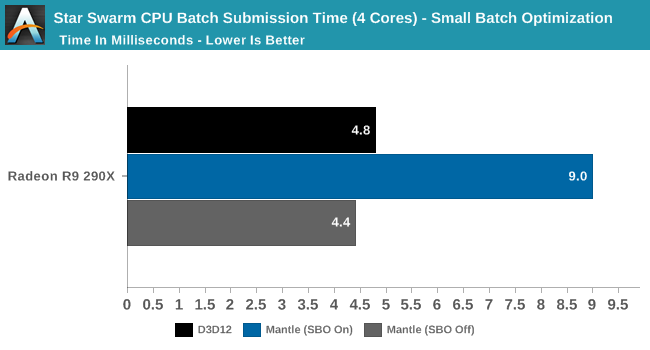
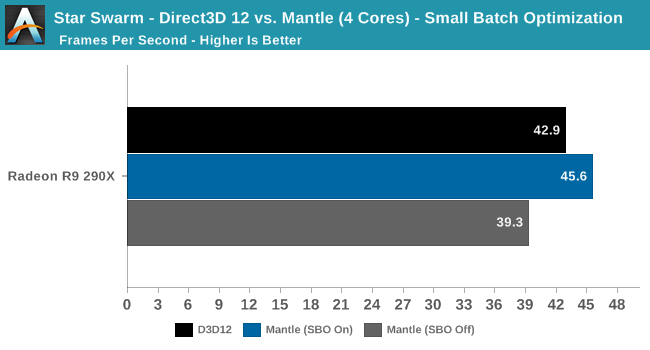
If we turn off the small batch optimization feature, what we find is that Mantle' s batch submission time drops nearly in half, to an average of 4.4ms. With the second pass removed, Mantle and DirectX 12 take roughly the same amount of time to submit batches in a single pass. However as Oxide noted, there is a performance hit; the Mantle rendering path's performance goes from being ahead of DirectX 12 to trailing it. So given sufficient CPU power to pay the price for batch optimization, it can have a signifcant impact (16%) on improving performance under Mantle.
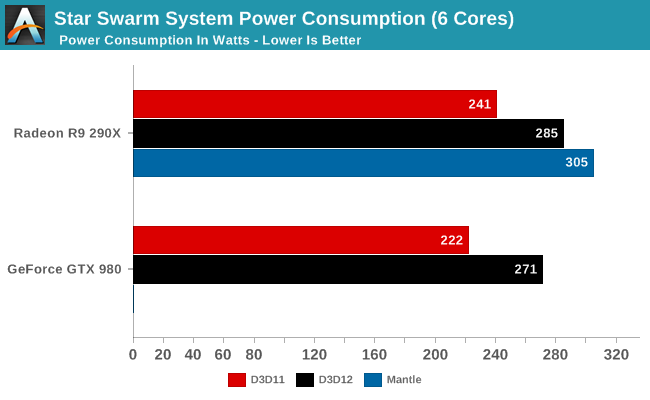
Finally, we wanted to take a quick look at power consumption among cards and APIs. To once again repeat what we said earlier, Star Swarm is an imperfect, non-deterministic benchmark, and coupled with the in-development status of DirectX 12 everything here is subject to change. However we thought this was interesting enough to include in our evaluation.
As expected, the increased throughput from DirectX 12 and Mantle drive up system power consumption. With the CPU no longer the bottleneck, the GPU never gets a chance to idle and video card power consumption ramps up to full load.










245 Comments
View All Comments
eanazag - Monday, February 9, 2015 - link
Yes, and they need more millions of machines to attract developers. Find any app that exists on iOS, Android, and Windows and you'll see that the Windows version is usually lagging in support or features. Example: Star Wars Commander receives the same updates iOS does weeks later.They absolutely need developers to get on board. When they do, there should be a corresponding stream of cash flow in the Windows store.
Blessedman - Tuesday, February 10, 2015 - link
This is 100% correct... Ask any Machead if they would prefer Max Excel or Windows Excel, it is a clear choice that the windows version of Excel is far away a better product. When they can develop for an audience, do you think they would rather show off their product on the niche market (anything other than windows)?Blessedman - Tuesday, February 10, 2015 - link
Errr This isn't 100% correct.SparkySamza - Tuesday, February 10, 2015 - link
yes but numbers on mac vs mac excel, numbers wins every time cause numbers is a boss.Christopher1 - Monday, February 16, 2015 - link
True, but Windows 8 has the Store and it is a PAID upgrade from Vista and 7 so..... that comparison sorts falls flat in the real world.ymcpa - Saturday, February 7, 2015 - link
It's free only for the first year and it's not free to OEMs and large enterprise customers, who use software assurance anyways. They want everyone to upgrade to create a large enough user base to attract developers again. This will benefit windows tablets and phones and might make them competitive against ios and android. The only thing really holding tablets and phones back is the app selection. On the other hand, Google's only reason for giving away free software and service s to establish a large user so that the can sell ads to target that user base. In that scenario, you are the product.bitcrazed - Saturday, February 7, 2015 - link
"It's free only for the first year .."No. Win 10 is a free upgrade if you upgrade within a year of initial release. There is no fee to be paid after the 1st year.
Because we now live in a world where one doesn't need to replace one's machine every 3 years in order to be able to run the next OS version, Microsoft has learned that it needs to incentivize users to upgrade to newer OS' in order to prevent what happened with XP:
Although Microsoft had released Vista, 7 and 8, until fairly recently, a considerable percentage of their userbase were still running XP. Microsoft had to extend the support lifespan of XP twice to avoid leaving XP users without an upgrade path, but still they refused to upgrade. Then Microsoft could do no more and even extended support expired resulting in a larger number of upgrades from XP.
My offering Win10 as a free upgrade, Microsoft (and the entire industry) hopes to encourage users to upgrade from their current OS - XP, Vista, 7 or 8.x to the new OS sooner rather than later.
hwangeruk - Saturday, February 7, 2015 - link
Eh? His "free for the first year" comment was correct, stop splitting hairs.Microsoft is not trying to prevent what happened with XP at all, that's just wrong.
MS need apps for mobile, so wants a mass of users to get the tablet and phone space back.
They also want to win some hearts and minds as Windows 8 had a mixed reception (even though after 8.1 updates it was fine, the damage was done. Like games with launch issues sometimes don't recover from negative early reviews)
This has 0 to do with XP, and the XP extended support for only for paying customers not generally consumers. This move has 0 to do with XP, you are so wrong on that.
zodiacfml - Sunday, February 8, 2015 - link
It is free. They put it for free for the first year of the OS so that people are forced to upgrade immediately and not any amount of time longer than that as it that defeats the purpose of putting a huge percentage of people into just one, current operating system.Besides, adopters would be will beta testers with little obligation from MS.
Wwhat - Sunday, February 8, 2015 - link
But what does windows10 desktop to do with getting the tablet and phone space? And what do you mean with "get the tablet and phone space back", back? MS never had that market ever, nor is MS likely to get it.But yes, they are likely hoping to gain from 'an appstore' and 'cloud' and the always listening and handy for advertisers and security services alike voice-command thing.
All of which exemplifies the reason to worry..